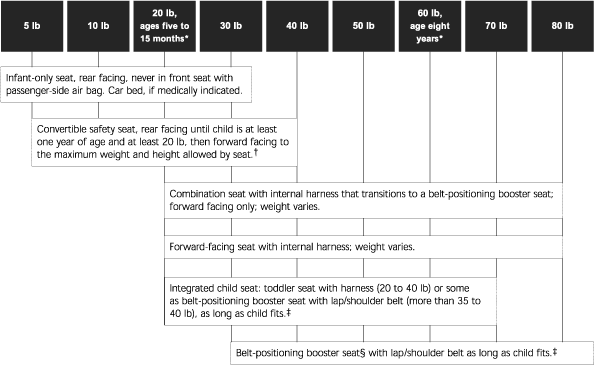
Am Fam Physician. 2002;66(3):509-512
A policy statement developed by the American Academy of Pediatrics (AAP) provides recommendations based on the available literature and lists some factors that parents should consider before buying a car safety seat for infants and children. The complete report appears in the March 2002 issue of Pediatrics. The current statement is intended to provide parents with appropriate up-to-date information about proper selection and use of car safety seats (see accompanying figure).

An appropriate safety seat is one that is the right size for the child, fits the vehicle's seats and seat belt systems, is easy for parents to use, and meets federal safety standards. Physicians should remind parents that the state laws may not always reflect the safest way to transport a child. They should also encourage parents to follow the AAP's recommendations for the best way to restrain a child.
Recommendations
The AAP provides recommendations on selecting and installing safety seats and how to place a child in the seat.
SEAT SELECTION
Children should face the rear of the vehicle until they are at least one year of age and weigh at least 20 lb. Infants younger than one year who weigh 20 lb should still face the back of the car in a convertible seat or one that is approved for higher weights. For optimal protection, the child should remain facing the rear of the car until reaching the maximum weight for the car safety seat, as long as the top of the child's head is below the top of the seat back.
Premature or small infants should not be placed in safety seats with shields, abdominal pads, or arm rests that could have contact with the infant's face or neck during an impact.
Parents of children who weigh more than 12 lb at four months of age should be encouraged to use a convertible safety seat that will allow for heavier weights and still face the rear of the car.
A convertible safety seat is positioned semireclined and facing the rear of the car for a child younger than one year weighing less than 20 lb. The seat is positioned upright and facing forward for an older and heavier child (up to 40 lb) and may be used as long as the tops of the child's ears are below the top of the safety seat and shoulders are below the seat strap slots.
A forward-facing seat, a combination seat, or a belt-positioning booster seat should be used when the child has outgrown a convertible seat but is still too small for the vehicle's safety belts. Vehicle safety belts should not be used until the shoulder belt can be positioned across the child's chest with the lap belt low and snug across the thighs. A booster seat should be used until the child is able to sit against the back of the seat with feet hanging down and legs bent at the knees.
Many new vehicles are equipped with built-in safety seats that are designed for forward-facing children who are older than one year and heavier than 20 lb. All younger and lighter infants should face the rear of the vehicle in a separate safety seat until they meet these two requirements.
On the basis of standards established by the National Highway Traffic Safety Administration, shield boosters have not been certified by manufacturers for children who weigh more than 40 lb. In current models, the shield can be removed and the restraint can be used with a lap and shoulder belt as a belt-positioning booster seat for children too big for the full harness. Children who weigh 40 lb or less are best protected in a seat with a full harness.
Until performance standards are developed for after-market add-on devices for adjusting poorly fitted seat belts, these products should not be used.
Children with special health care needs should have the appropriate restraint systems.
INSTALLATION IN VEHICLE
A rear-facing safety seat must not be placed in the front passenger seat of any vehicle that has an air bag on the passenger side.
The back seat of a vehicle is the safest place for children of any age to ride.
Parents should read the vehicle instruction manual and child restraint device instructions carefully. When the safety seat is installed, it should be tested for a snug fit and any compatibility problems with the vehicle seat or seat belt.
Infants should ride at approximately a 45-degree angle to prevent slumping and airway obstruction. The infant's head should not flop forward.
Experience with side air bags and safety seats is limited, but laboratory simulations have indicated that unrestrained and out-of-position children are at risk of serious injury. Parents should consider placing children and safety seats away from all air bags, choosing a vehicle without side air bags in the back seat, or deactivating them if children are transported in adjacent positions.
PLACEMENT OF CHILD IN SEAT
In rear-facing safety seats for infants, shoulder harnesses should be placed in the slots at or below the shoulders. The harness should be snug, and the retainer clip should be positioned at the level of the infant's armpit, not on the abdomen or neck area.
In forward-facing seats for older children, the shoulder strap should be at or above the child's shoulders, the harness should be snug, and the retainer clip should be positioned level with the child's armpits. This seat should be used until the child reaches the maximum weight or height limit.
A child should never be left unattended in a safety seat in or out of the car.